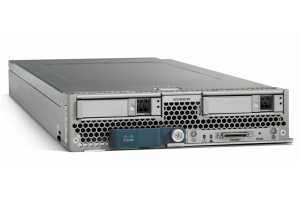Categorieën
Cisco - Cisco UCS B200 M3 server 16 GB Lemmet Intel® Xeon® E5 familie E5-2650 2 GHz 128 GB DDR3-SDRAM
| Productinformatie | |
| Categorie | Servers |
| Voorraad | 0 |
| Levertijdsindicatie | Neem contact op met afdeling sales |
| Artikelnummer | UCS-EZ-ENTV-B200M3 |
| EAN/UPC | 0882658583841 |
| Beschrijving |
|
Cisco UCS B200 M3. Processorfamilie: Intel® Xeon® E5 familie, Frequentie van processor: 2 GHz, Processormodel: E5-2650. Intern geheugen: 128 GB, Intern geheugentype: DDR3-SDRAM. Totale opslagcapaciteit: 16 GB. Ethernet LAN. Type behuizing: Lemmet
The Cisco Unified Computing System (Cisco UCS) combines Cisco UCS B-Series Blade Servers and C-Series Rack Servers with networking and storage access in a single converged system that simplifies management and delivers greater cost efficiency and agility with increased visibility and control. The Cisco UCS B200 M3 Blade Server delivers performance, versatility, and density without compromise. It addresses the broadest set of workloads, from IT and web infrastructure, through distributed database. The enterprise-class Cisco UCS B200 M3 Blade Server further extends the capabilities of the Cisco UCS portfolio in a half-width blade form factor. The Cisco UCS B200 M3 harnesses the power of the latest Intel Xeon processor E5-2600 and E5-2600 v2 product families, with up to 768 GB of RAM (using 32-GB DIMMs), two disk drives, and up to dual 4x 10 Gigabit Ethernet throughput. In addition, Cisco UCS has the architectural advantage of not having to power and cool excess switches in each blade chassis. With a larger power budget per blade server, Cisco can design uncompromised expandability and capabilities in its blade servers, as evidenced by the new Cisco UCS B200 M3, with its leading memory slot and drive capacity. The Cisco UCS B200 M3 provides: - One or two, multi-core, Intel Xeon processor E5-2600 and E5-2600 v2 product families CPUs, for up to 24 processing cores - 24 DIMM slots for industry-standard double-data-rate 3 (DDR3) memory running up to 1866 MHz and up to 768 GB of total memory (using 32-GB DIMMs) - Two optional, hot-pluggable SAS or SATA hard disk drives (HDDs) or solid-state drives (SSDs) - Industry-leading 80 Gbps throughput bandwidth - Remote management through a Cisco Integrated Management Controller (CIMC) that implements policy established in Cisco UCS Manager - Out-of-band access by remote keyboard, video, and mouse (KVM) device, Secure Shell (SSH) Protocol, and virtual media (vMedia) as well as the Intelligent Platform Management Interface (IPMI) In addition, the Cisco UCS B200 M3 is a half-width blade (Figure 1). Up to eight of these high-density, two-socket blade servers can reside in the 6RU Cisco UCS 5108 Blade Server Chassis, offering one of the highest densities of servers per rack unit in the industry. Another Cisco innovation, the Cisco UCS Virtual Interface Card (VIC) 1240 is a 4-port 10 Gigabit Ethernet, Fibre Channel over Ethernet (FCoE)-capable modular LAN on motherboard (LOM) designed exclusively for the M3 generation of Cisco UCS B-Series Blade Servers. When used in combination with an optional I/O expander, the Cisco UCS VIC 1240 capabilities can be expanded up to eight ports of 10 Gigabit Ethernet. The Cisco UCS VIC 1240 enables a policy-based, stateless, agile server infrastructure that can present up to 256 PCI Express (PCIe) standards-compliant interfaces to the host that can be dynamically configured as either network interface cards (NICs) or host bus adapters (HBAs). In addition, the Cisco UCS VIC 1240 supports Cisco® Data Center Virtual Machine Fabric Extender (VM-FEX) technology, which extends the Cisco UCS fabric interconnect ports to virtual machines, simplifying server virtualization deployment. The Cisco UCS B200 M3 Blade Server continues Cisco’s commitment to delivering uniquely differentiated value, fabric integration, and ease of management that is exceptional in the marketplace. The Cisco UCS B200 M3 further extends the capabilities of Cisco UCS by delivering new levels of manageability, performance, energy efficiency, reliability, security, and I/O bandwidth for enterprise-class applications: Applications The Cisco UCS B200 M3 is suited for a broad range of IT workloads: - Virtualized workloads - IT and web infrastructure - Virtual desktops - Databases - Middleware - Enterprise resource planning (ERP) and customer relationship management (CRM) applications Cisco UCS Servers Change the Economics of the Data Center IT infrastructure matters now more than ever, as organizations seek to achieve the full potential of infrastructure as a service (IaaS), bare metal, virtualized servers, and cloud computing. Cisco continues to lead in Data Center innovation with the introduction of new building blocks for the Cisco Unified Computing System that extend its exceptional simplicity, agility, and efficiency (Figure 2). Innovations such as the Cisco UCS B200 M3 Blade Server bring even better industry-leading performance from IT infrastructure to enterprise applications. Cisco innovations, such as the Cisco UCS Manager software, allow administrators to create a software model of a desired server (using Cisco service profiles and templates) and then instantiate that server and its I/O connectivity by associating a model with physical resources. This approach contrasts with the traditional approach of configuring each system resource manually, one at a time, through individual element managers. Unlike legacy vendors of traditional systems, Cisco uses a unified management model with service profiles that can be moved easily between any Cisco UCS servers - whether blade server or rack server - in a Cisco UCS Manager domain. Other Cisco UCS building blocks include new Cisco UCS VIC options, expanded Cisco UCS fabric interconnects, and additional fabric extender options that expand throughput and management simplicity for both blade and rack servers across bare-metal, virtualized, and cloud environments. Cisco UCS also provides investment protection. For example, fabric extenders can be upgraded in the same Cisco UCS 5108 Server Chassis using the same fabric interconnects. Fabric interconnects can be upgraded independently of fabric extenders and blade servers within the chassis. The Cisco UCS 5108 Chassis high-performance midplane provides 8 blades with 1.2 terabits (Tb) of available Ethernet throughput for future blade and I/O requirements. In addition, Cisco continues to innovate in all these areas, helping ensure that newer, more powerful blade servers have matching I/O bandwidth and computing power through continuous innovation across the Cisco UCS environment. The Cisco UCS B200 M3 is also part of a large family of blade servers: the Cisco B-Series Blade Servers. Designed to operate as part of Cisco UCS, the Cisco UCS B-Series servers employ many innovative Cisco technologies to help customers handle the most challenging workloads. Cisco UCS B-Series servers operating in a Cisco UCS management framework incorporate a standards-based unified network fabric, Cisco VM-FEX virtualization support, Cisco UCS Manager software, Cisco fabric extender architecture, and Cisco Extended Memory Technology. Again, Cisco is innovating across all these technologies. Together, these Cisco UCS architectural advantages and Cisco’s software advances, Cisco’s continuous innovation, and unique blade server and chassis designs combine to make Cisco UCS the first truly unified data center platform. In addition, Cisco UCS can transform IT organizations through policy-based automation and deep integration with familiar systems management and orchestration tools. |
Test Test Test Test Test
Test Test Test Test Test
Test Test Test Test Test
Test Test Test Test Test
Test Test Test Test Test
Test Test Test Test Test
Test Test Test Test Test
Test Test Test Test Test
Test Test Test Test Test

Hogere prestaties wanneer u het nodig hebt
Intel® Turbo Boost Technologie 2.0 versnelt de prestaties van de processor en de grafische prestaties door de werkfrequentie te verhogen als er onder de specificatiegrenzen gewerkt wordt. De maximale frequentie varieert afhankelijk van de werklast, hardware, software en de algehele systeemconfiguratie.
Intel® Turbo Boost Technologie 2.0 versnelt de prestaties van de processor en de grafische prestaties door de werkfrequentie te verhogen als er onder de specificatiegrenzen gewerkt wordt. De maximale frequentie varieert afhankelijk van de werklast, hardware, software en de algehele systeemconfiguratie.

Simplify Virtualization and Reduce Overheads
Intel® Virtualization Technology (Intel® VT) helps make virtualization practical by eliminating performance overheads, reducing complexity, and improving security with hardware assistance. Virtualization allows multiple workloads to share a common set of resources so that a variety of workloads can co-locate while maintaining full isolation from each other.
Intel® Virtualization Technology (Intel® VT) helps make virtualization practical by eliminating performance overheads, reducing complexity, and improving security with hardware assistance. Virtualization allows multiple workloads to share a common set of resources so that a variety of workloads can co-locate while maintaining full isolation from each other.

Extra veiligheid met snellere data-encryptie
De Intel® Advanced Encryption Standard New Instructions (Intel® AES-NI) maakt snelle en veilige data-encryptie en -decryptie mogelijk voor een betere prestatie en minder risico door tijd- en cache-gebaseerde aanvallen dan bij table-based software-implementaties. Intel AES-NI ondersteunt het gebruik van standaard sleutellengtes, standaardwerkwijzen en zelfs sommige niet-standaard of toekomstige varianten.
De Intel® Advanced Encryption Standard New Instructions (Intel® AES-NI) maakt snelle en veilige data-encryptie en -decryptie mogelijk voor een betere prestatie en minder risico door tijd- en cache-gebaseerde aanvallen dan bij table-based software-implementaties. Intel AES-NI ondersteunt het gebruik van standaard sleutellengtes, standaardwerkwijzen en zelfs sommige niet-standaard of toekomstige varianten.

Laatst bekeken









